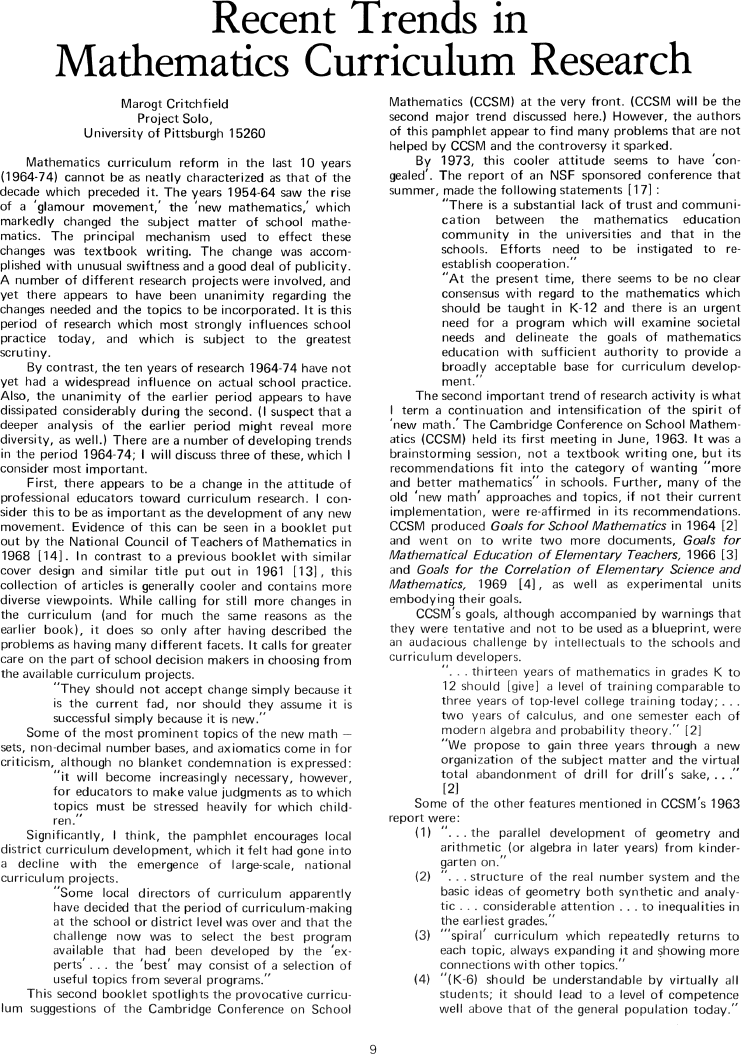The Best of Creative Computing Volume 1 (published 1976)
Recent Trends in Mathematics Curriculum Research (from 1964-1974)

Recent Trends in
Mathematics Curriculum Research
Marogt Critchfield
Project Solo,
University of Pittsburgh 15260
Mathematics curriculum reform in the last 10 years
(1964-74) cannot be as neatly characterized as that of the
decade which preceded it. The years 1954-64 saw the rise
of a 'glamour movement,' the 'new mathematics,' which
markedly changed the subject matter of school mathematics. The principal
mechanism used to effect these changes was textbook writing. The change was
accomplished with unusual swiftness and a good deal of publicity.
A number of different research projects were involved, and
yet there appears to have been unanimity regarding the
changes needed and the topics to be incorporated. It is this
period of research which most strongly influences school
practice today, and which is subject to the greatest
scrutiny.
By contrast, the ten years of research 1964-74 have not
yet had a widespread influence on actual school practice.
Also, the unanimity of the earlier period appears to have
dissipated considerably during the second. (I suspect that a
deeper analysis of the earlier period might reveal more
diversity, as well.) There are a number of developing trends
in the period 1964-74; I will discuss three of these, which I
consider most important.
First, there appears to be a change in the attitude of
professional educators toward curriculum research. I consider this to be as
important as the development of any new movement. Evidence of this can be seen
in a booklet put out by the National Council of Teachers of Mathematics in
1968 [14]. ln contrast to a previous booklet with similar
cover design and similar title put out in 1961 [13], this
collection of articles is generally cooler and contains more
diverse viewpoints. While calling for still more changes in
the curriculum (and for much the same reasons as the
earlier book), it does so only after having described the
problems as having many different facets. It calls for greater
care on the part of school decision makers in choosing from
the available curriculum projects.
"They should not accept change simply because it
is the current fad, nor should they assume it is
successful simply because it is new."
Some of the most prominent topics of the new math sets, non-decimal number
bases, and axiomatics come in for criticism, although no blanket condemnation is
expressed:
"it will become increasingly necessary, however,
for educators to make value judgments as to which
topigs must be stressed heavily for which children.
Significantly, I think, the pamphlet encourages local
district curriculum development, which it felt had gone into
a decline with the emergence of large-scale, national
curriculum projects.
"Some local directors of curriculum apparently
have decided that the period of curriculum-making
at the school or district level was over and that the
challenge now was to select the best program
available that had been developed by the 'experts'...the 'best' may consist of a
selection of useful topics from several programs."
This second booklet spotlights the provocative curriculum suggestions of the
Cambridge Conference on School Mathematics (CCSM) at the very front. (CCSM will
be the second major trend discussed here.) However, the authors
of this pamphlet appear to find many problems that are not
helped by CCSM and the controversy it sparked.
By 1973, this cooler attitude seems to have 'congealed'. The report of an NSF
sponsored conference that summer, made the following statements [17] :
"There is a substantial lack of trust and communication between the mathematics
education community in the universities and that in the
schools. Efforts need to be instigated to reestablish cooperation."
"At the present time, there seems to be no clear
consensus with regard to the mathematics which
should be taught in K-12 and there is an urgent
need for a program which will examine societal
needs and delineate the goals of mathematics
education with sufficient authority to provide a
broadly acceptable base for curriculum development."
The second important trend of research activity is what
term a continuation and intensification of the spirit of
'new math.' The Cambridge Conference on School Mathematics (CCSM) held its first
meeting in June, 1963. It was a brainstorming session, not a textbook writing
one, but its recommendations fit into the category of wanting "more
and better mathematics" in schools. Further, many of the
old 'new math' approaches and topics, if not their current
implementation, were re-affirmed in its recommendations.
CCSM produced Goals for School Mathematics in 1964 [2]
and went on to write two more documents, Goals for
Mathematical Education of Elementary Teachers, 1966 [3]
and Goals for the Correlation of Elementary Science and
Mathematics, 1969 [4], as well as experimental units
embodying their goals.
CCSM's goals, although accompanied by warnings that
they were tentative and not to be used as a blueprint, were
an audacious challenge by intellectuals to the schools and
curriculum developers.
"...thirteen years of mathematics in grades K to
12 should [give] a level of training comparable to
three years of top-level college training today; ...
two years of calculus, and one semester each of
modern algebra and probability theory," [2]
"We propose to gain three years through a new
organization of the subject matter and the virtual
total abandonment of drill for drill's sake ,... "
[2]
Some of the other features mentioned in CCSM's 1963
report were:
(1) "...the parallel development of geometry and
arithmetic (or algebra in later years) from kindergarten on."
(2) "...structure of the real number system and the
basic ideas of geometry both synthetic and analytic...considerable
attention...to inequalities in
the earliest grades."
(3) "'spiral' curriculum which repeatedly returns to
each topic, always expanding it and showing more
connections with other topics."
(4) "(K-6) should be understandable by virtually all
students; it should lead to a level of competence
well above that of the general population today."


